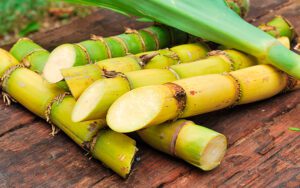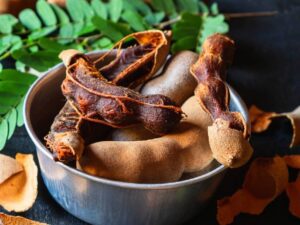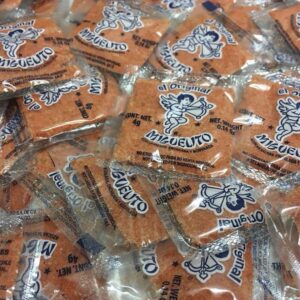The whole world believes that us Mexicans have a crazy obsession with chiles and that everything we eat is spicy and you know what? they’re probably right. We use chiles in the least expected ways and one of my favorite example is Mexican Candy, for us, it is just normal to mix spicy and sweet, and the truth is that the rest of the world does not understand why… Until they taste it for themselves.
The variety of sweets is a very important part of our culture. The pleasure we get with its flavor creates a nostalgia that takes us back to our childhood, or our hometown especially when traveling or living abroad.
A wide diversity of regional ingredients, fruits, and techniques from each state of the Mexican Republic is what marks the identity of the sweets.
We are never too old to have candy or to discover new flavors, and cool facts about them. Let’s get to know a little bit more of our love and use for chiles in this particular aspect of Mexican Gastronomy.
 Source: gastrolabweb.com
Source: gastrolabweb.com
SUGAR… OH HONEY, HONEY!
In Mesoamerica, before the Spaniards arrived, some typical drinks and sweets were already prepared by mixing fruits, seeds, some species and honey.
The honey was used for alegrias (amaranth brittles) and palanquetas (pumpkin seeds or peanuts brittles). The reheated mead was used to cover fruits and the women cooks used to crush the prickly pear (Nopal fruit) until they obtained a sweet and transparent layer that was stirred with amaranth and served as a dessert, a true delicacy.
 Source: elpoderdelconsumidor.org
Source: elpoderdelconsumidor.org
At the time of the Conquest, sugar cane was introduced to Mexican territories. Cane honey, piloncillo, and mainly sugar were about to upgrade our culinary creations. Most of the sweets were made with native fruits, and with the intention of supporting evangelization, they combined European culinary customs with indigenous ones.
Our country has a rich sweet tradition, the list is headed by Puebla with its recognizable poblano sweet potato candy, followed closely by Tlaxcala, Querétaro, Mexico City, Hidalgo, Oaxaca, and Yucatan. Sweets such as coconut-stuffed lime, tarugos made with tamarind pulp and dry chiles and cocadas, were originated in convents making them icons of the local cuisine of each region.
TAMARIND
A TROPICAL FRUIT.
 Source: cocinadelirante.com
Source: cocinadelirante.com
The history of tamarind in Mexico begins during the Colony when it arrived along with the Spaniards to America, native to South Asia and tropical Africa. Its cultivation went so well that it spread throughout the tropical areas of the country. The use of tamarind became so popular as a fundamental element of our gastronomy.
Although it is more common to see tamarind in sweets or as a condiment for salsas, its plant is also used in other industries, such as black dye, glue, insecticides, paper and furniture. It also has an important medicinal use since, thanks to its laxative, diuretic, astringent, antipyretic and antiseptic properties and with its branches, roots, leaves, seeds and fruit, remedies are developed for liver diseases, fever, asthma, alcohol poisoning and digestive problems. Rich in mineral salts, among which potassium, iron and phosphorus stand out. And in vitamins such as C, A and vitamin B3.
The fresh pulp is characterized by its sweet and sour taste, actually one of the most common flavors of fresh water in Mexico is tamarind. In many states such as Veracruz and Guerrero, tamarind pulp is sold on the roadsides, packaged with or without seeds and mixed with sugar or chiles.
Tamarind pulp is usually mixed with chamoy, dehydrated fruits or other Chile powder and can be found in endless presentations such as Cazuelitas, (a personal favorite) in plastic spoons, in little balls such as tarugos or the famous pelon pelo rico .
 Source: increible.co
Source: increible.co
CHAMOY…
THE FLAVOR OF ANY MEXICAN CHILDHOOD
Chamoy is a sauce based on dried plum or apricot, chile, salt, vinegar and sugar, and is undoubtedly a Mexican favorite. Being neither so spicy nor so sweet, chamoy achieves a perfect balance when it comes to adding to any food.
 Source: directoalpaladar.com.mx
Source: directoalpaladar.com.mx
Despite being so popular in Mexico, this sauce has its origin in Japan. Chamoy is derived from a Japanese dish called umeboshi, which is traditionally made with Japanese plum fermented with salt and then pressed to extract all the juice. Before being consumed it is dyed red, using shiso leaves, which gives it a very characteristic appearance. (making it the bane of white shirts)
Chamoy is also prepared with fruits such as mango and can be consumed alone or as a sauce accompanying other dishes. It is used in snacks such as fried foods, fruits or vegetables and in the preparation of cocktails.
The Japanese tried to introduce the product to the market as a food condiment, but in Mexico it was more accepted as candy. After several years working for the Iwadare family, who were of Japanese origin, Mr. Felipe Zúñiga Chávez, created a bond of trust which consequently lead to Mr. Iwadare sharing his original and delicious Chamoy recipe with him. Sometime later, he began to produce and sell the product to small Mexican stores, and the rest is history.
ALL-TIME FAVORITE CHOICES TO SPICE IT UP
Salsa Valentina – The most popular bottled Mexican hot sauce, an explosive and delicious combination of chiles, is the main element in the Mexican snack mise en place, great for popcorn, peanuts, chicken wings, fruits or chips. Honestly, if you have a Mexican friend that leaves abroad, and you’re coming to Mexico on vacation, nothing will make your Mex-Pats friends happier than a bottle of Valentina.
 Source: gourmetdemexico.com.mx
Source: gourmetdemexico.com.mx
Tamaroca – Since 1975 the favorite is the pellizco, but whether it is a tamarind lollipop or just a tamarind stick, they are made with 100% natural tamarind pulp with powdered chile de arbol.
Tajin – Seasoning powder, madre from ground chili peppers, sea salt, and dehydrated lime juice. The powder is tangy and spicy, and often added to food and fruits as a condiment. Occasionally used in micheladas and margaritas.
Miguelito – In 1970, the company “Miguelito” was born, responsible for distributing liquid chamoy and the famous dry chili powder with salt and sugar, excellent for giving fresh fruits a spicy but sweet taste.
 Source: marialabonita.com
Source: marialabonita.com
Now, in all fairness, not EVERY kind of Mexican Candy IS spicy, we have great chocolate, our delicious pan dulce, palanquetas, ate, and so much more, but for now I want to leave things spicy.
Writing these articles is not easy at all, requiring tons of research and dedication, like going to the little store down the street to stock up on a large supply of spicy sweets, just for inspiration. I don’t want to tell you how it went with the article about Mole… So this time I’ll just say goodbye and remind you, Mexico is always waiting to surprise you and blow your mind with its spicy culture.
Until next time.
-Sweet (and Spicy) Tooth Abbey.






